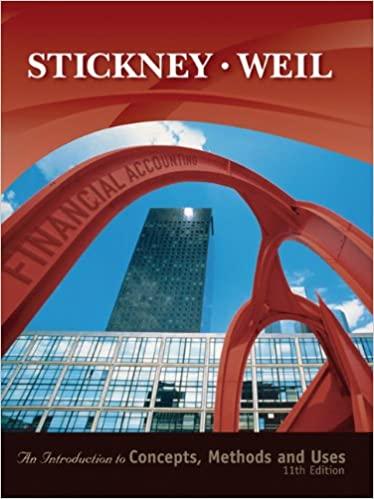Preparing adjusting entries. To achieve efficient recording of day-to-day cash receipts and disbursements relating to operations, a
Question:
Preparing adjusting entries. To achieve efficient recording of day-to-day cash receipts and disbursements relating to operations, a firm may credit all cash receipts to revenue accounts and debit all cash disbursements to expense accounts. The efficiency stems from treating all receipts in the same way and all disbursements in the same way. The firm can program its computer to automatically record operating cash receipts and disbursements in this way. In the day-to-day recording of transactions, the computer program need not be concerned with whether a specific cash transaction reflects settlement of a past accrual, a revenue or expense correctly assigned to the current period, or a prepayment relating to a future period. At the end o( the period, accountants analyze the existing account balances and construct the adjusting entries required to correct them. This process results in temporarily incorrect balances in some balance sheet and income statement accounts during the accounting period.
Construct the adjusting entry required for each of the following scenarios.
a. On September 1. Year 2. a tenant paid $24,000 rent for the one-year period starting at that time. The tenant debited the entire amount to Rent Expense and credited Cash. The tenant made no adjusting entries for rent between September 1 and December 31. Construct the adjusting entry to he made on December 31, Year 2, to recognize the proper balances in the Prepaid Rent and Kent Expense accounts. What is the amount of Rent Expense for Year 2?
b. Refer to part
a. The tenant's books for December 31, Year 2, after adjusting entries, show a balance in the Prepaid Rent account of $16,000. This amount represents rent for the period January 1 through August 31, Year 3. On September 1, Year 3, the tenant paid $30,000 for rent for the one year period starting September 1, Year 3. The tenant debited this amount to Rent Expense and credited Cash but made no adjusting entries for rent during Year 3. Construct the adjusting entry required on December 31, Year 3. What is Rent Expense for Year 3?
C. Refer to part
b. The tenant's books for December 31, Year 3, after adjusting entries, show a balance in the Prepaid Rent account of $20,000. This amount represents rent for the period January 1 through August 3 1 . Year 4. On September 1 , Year 4, the tenant paid $18,000 for rent for the six-month period starting September 1, Year 4. The tenant debited this amount to Rent Expense and credited Cash but made no adjusting entries during Year 4. Construct the adjusting entry required on December 31. Year 4. What is Rent Expense for Year 4?
d. Whenever the firm makes payments for wages, it debits Wage Expense. At the start of April, the Wages Payable account had a balance of $5,000. representing wages earned but not paid during the last few days of March. During April, the firm paid $30,000 in wages, debiting the entire amount to Wage Expense. At the end of April, analysis of amounts earned since the last payday indicates that employees have earned wages of $4,000 that they have not received. These are the only unpaid wages at the end of April. Construct the required adjusting entry. What is Wage Expense for April?
e. A firm purchased an insurance policy providing one year's coverage from May 1, Year 1, and debited the entire amount to Insurance Expense. After the firm made adjusting entries, the balance sheet on December 31. Year 1. correctly showed Prepaid Insurance of $3,000.
Construct the adjusting entry that the firm must make on January 31, Year 2, if the firm closes its books monthly and prepares a balance sheet for January 31, Year 2.
f. The recordkeeping system for an apartment building instructs the bookkeeper always to credit rent revenue when the firm collects a payment from tenants. At the beginning of Year 3, the liability account Advances from Tenants had a credit balance of $25,000, representing collections from tenants for rental services to be rendered during Year 3. During Year 3, the firm collected $250,000 from tenants; it debited Cash and credited Rent Revenue. It made no adjusting entries during Year 3. At the end of Year 3, analysis of the individual accounts indicates that of the amounts already collected. $30,000 represents collections for rental services to be provided to tenants during Year 4. Present the required adjusting entry. What is Rent Revenue for Year 3?
g. When the firm acquired new equipment costing $10,000 on January 1, Year 1, the bookkeeper debited Depreciation Expense and credited Cash for $10,000 but made no further entries for this equipment during Year 1 . The equipment has an expected service life of five years and an estimated salvage value of zero. Construct the adjusting entry required before the accountant can prepare a balance sheet for December 3 1 , Year 1 .
Step by Step Answer:

Financial Accounting Introduction To Concepts Methods And Uses
ISBN: 9780324222975
11th Edition
Authors: Clyde P. Stickney, Roman L. Weil





